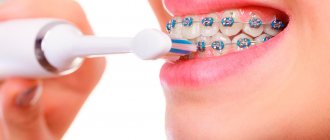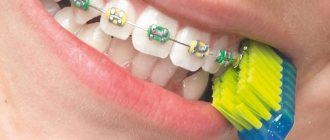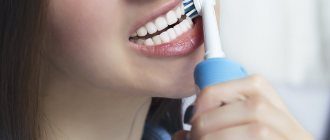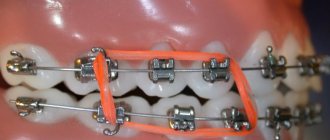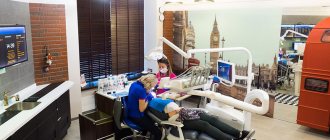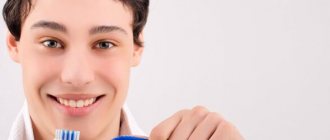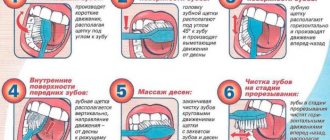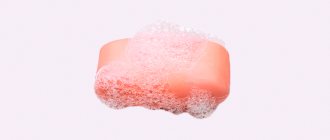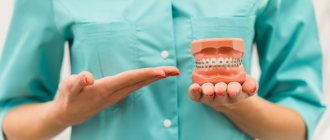During orthodontic treatment, patients experience difficulties with oral hygiene. This happens because the braces themselves and the arch that connects them prevent a regular toothbrush from cleaning plaque and food debris from the dental spaces. Moreover, the foreign complex structure itself becomes an additional source of infection, collecting the same food debris on the surface.
This problem can have serious consequences, since the dentist’s ability to prevent and treat caries while the patient is wearing braces is also significantly limited. Taking this fact into account, it is worthwhile to monitor oral hygiene as carefully as possible during the active phase of bite correction. You need to purchase everything for caring for braces from an online store or pharmacy. The dentist will definitely give you a list of necessary devices after installing the orthodontic structure.
What are braces and why are they needed?
Braces are an orthodontic structure designed to correct the bite and straighten the teeth. They are worn to correct misaligned teeth and achieve a beautiful smile. Braces systems consist of individual brackets, which are attached to the surface of the teeth using special glue and connected to each other with a metal arch. The latter has shape memory; under its pressure, the teeth move to the correct position.
In this article
- What are braces and why are they needed?
- How long do you wear braces?
- Can wearing braces harm your teeth?
- What products will be needed for care?
- Can I clean my braces with a regular brush?
- What brushes can be used to care for the braces system?
- Can I clean my braces with an electric brush?
- Is an ultrasonic brush suitable for caring for braces?
- How to brush teeth with braces: the correct algorithm
- How else can you clean your braces?
- Professional cleaning
- What foods are not recommended to be consumed while wearing braces?
- The secret to a beautiful smile and healthy teeth
Only at first glance, braces seem to be a simple device. In practice, this is a complex structure, the manufacture of which requires jewelry precision.
Why do my teeth hurt after installing and activating braces?
In the first days after installation, and subsequently after activation of braces, aching sensations of varying degrees of intensity are possible - the stronger the defect, the greater the pain. When fixing ligature systems, the pressure is greater, so the teeth will hurt more. Soreness in general is a completely normal reaction, since braces from the first minutes after fixation already have an impact on the teeth and change their position.
If the pain is severe, then in the first days after installation or activation of the system, you can take painkillers. But no more than 2-3 days. If discomfort persists, contact your orthodontist for system correction.
Can wearing braces harm your teeth?
There is an opinion that braces can ruin teeth, damage enamel, and provoke the development of caries and other oral diseases. Dentists claim that modern braces installed by a professional orthodontist in a good clinic are absolutely safe for your teeth if you are not allergic to the materials.
Problems arise when the user violates the doctor’s recommendations and neglects the rules of hygienic care. If you do not properly and thoroughly clean your braces and the teeth underneath them, then pathological processes may begin in the oral cavity. Plaque that accumulates near braces promotes the proliferation of microbes and increases the risk of developing caries, gingivitis, and stomatitis.
This is easy to prevent; you just need to brush your teeth with braces in a timely manner and correctly.
Make an appointment with the dentist
If you experience discomfort from an incorrect bite or need to have your braces adjusted, then contact the EliteDental M dental clinic. Our dentists will conduct a professional examination of your mouth and help you install or adjust braces.
+7(863) 310-10-81, Rostov-on-Don, st. Zhdanova 3.
+7(863) 310-98-80, Rostov-on-Don, st. Mironova 6. Opening hours: Monday – Friday from 09.00 to 20.00. Saturday from 10.00 to 17.00. Sunday is a day off.
What products will be needed for care?
To ensure thorough care of an orthodontic structure such as braces, a set of hygienic measures is needed. The following devices and tools will help provide them.
- Toothbrush.
It should have soft bristles that will not damage the structure. You can purchase a special orthodontic one. V-neck model with stubble.
- Paste with calcium and fluoride.
These substances in toothpaste will strengthen the enamel and help prevent the risk of damage.
- Ershik.
Special brushes help remove food debris and plaque from under the metal arch and around the brackets.
- Super floss.
Orthodontic dental floss designed specifically for cleaning braces, dentures and other dental structures.
- Irrigator.
This device is ideal for gentle and effective care of braces. To clean them of dirt, you need to buy a device with a special orthodontic attachment. The irrigator cleans the structure using a water jet under pressure and, additionally, the mechanical action of the bristles of the nozzle.
- Mouth rinse solution.
Its use soothes the gums and prevents the growth of bacteria.
Home care rules
At first it will seem to you that the cleansing procedure has become more complicated. Before braces, a brush and dental floss a couple of times a week were enough. Now we need to constantly use a whole arsenal of tools. Gradually you will get used to it and it will stop taking a lot of time.
The first “weapon” without which victory over plaque and bacteria is impossible is a brush.
Orthodontic toothbrush
Replace the old brush with an orthodontic one, the difference of which is the V-shape. There is a groove in the middle between the villi. This design allows cleaning without touching the braces. The bristles pass over the surfaces of the teeth without getting stuck anywhere.
You can brush your teeth like this: apply the paste and walk in a circular motion over each area of the front and back surfaces of the teeth. We clean under the metal wire at an angle. Don’t forget about the “sevens” and “eights” - they are usually given little attention, and plaque accumulates there.
We change the brush every 2 months!
Yorshik
In Soviet times, milk was sold in glass bottles with narrow necks. In order not to throw away useful containers, housewives washed them with brushes - bristly devices with a long handle.
Cleaning from below Cleaning from above Finally, superfloss
A similar brush exists in dentistry today. It cleans the surface of the back row of teeth well. They cope with the accumulation of food in the interdental spaces. Procedure: reciprocating movements. This ensures cleaning and gentle massage of the gums.
Dental floss
Flossing has long been popular in the West. This “special tool” came to us a couple of decades ago and has not yet become widespread. No matter how you feel about dental floss, you cannot do without it when wearing braces.
Varieties:
- thin threads;
- narrow ribbons;
- waxed floss;
- not waxed threads;
- superfloss.
At first, try using waxed thread. It is more suitable for beginners because it glides easily without touching anything. We wrap each tooth with a thread and move it up and down. The length of the cut piece is 40 cm (enough to fix the thread with your fingers). After treating one area, throw away the used piece and cut a new one.
You can apply toothpaste to the floss, enhancing the disinfecting and anti-inflammatory effect.
When you get used to the thread, switch to the variation that is intended for structures with braces - superfloss. Its difference is that one end is thin, the other is unfibered. This shape allows you to remove plaque from hard-to-reach places.
Irrigator
A reservoir filled with liquid that removes plaque and food debris. It is supplied under pressure using special nozzles.
Useful video for those who wear braces:
An irrigator is useful for all family members, so buy it without hesitation. Everyone will install their own nozzle. And with braces, the device becomes not a luxury, but a necessity.
Pastes
You can choose from 2 groups (based on the recommendations of your doctor):
- hygienic;
- therapeutic and prophylactic.
The first ones are suitable for everyone, the second ones are good when there is a danger of problems with teeth or gums. Therapeutic and prophylactic pastes are represented by fluorine-containing and calcium-containing ones. The lack of these microelements gives impetus to the development of caries.
When wearing braces, it is important to monitor the condition of your gums. Unusual load causes:
- gingivitis;
- stomatitis;
- periodontitis.
For protection, look for pastes on the shelves labeled: “Anti-inflammatory effect, prevention of gum disease.”
What brushes can be used to care for the braces system?
The set of special brushes for braces includes three types:
- orthodontic;
- monobeam;
- interdental
An orthodontic brush has bristles of different lengths. They are short in the center to better clean the protruding parts of the braces, and long at the edges to remove plaque from the surface of the teeth. Thanks to this design, the bristles do not get tangled in the clasps of the brackets, while cleaning the surfaces well.
Use a mono-beam toothbrush to remove deposits from under locks and hard-to-reach areas. Structurally, it consists of a handle and a cleaning head with one tuft of long bristles. Typically used as an addition to an orthodontic brush.
The interdental brush resembles a brush in appearance: its bristles are arranged spirally around a wire base. Use a brush to clean the interdental spaces and surfaces of the teeth under the arch.
Can I use an electric toothbrush?
Ultrasonic is not possible, conventional electric is possible. The first can lead to the plates coming off, the second should not have a moving head and strong vibration - this will not harm the braces, but it will be inconvenient for you to use such a brush, since the bristles will get stuck. You can use several toothbrushes at once - a regular one to clean the inner surface of the teeth, and an orthodontic one to clean the outer surface where the braces are located.
“The braces are fixed quite securely - you need to try hard to peel them off the surface of the teeth. Therefore, hygiene must be carried out without fear and in no case reducing its intensity, making allowances for braces. If the care is poor, after removing the system we will find caries and white spots on the enamel.”
Rustamova Gunel Bakhmanovna, dentist-orthodontist, work experience more than 3 years make an appointment
Is an ultrasonic brush suitable for caring for braces?
Among electric toothbrushes, there are ultrasonic models that act on oral impurities using ultrasound. A number of dentists do not recommend using ultrasonic brushes to clean braces, as they can lead to rapid wear and damage to the structure. Others allow the use of an ultrasonic brush to clean orthodontic appliances.
To avoid damage to the structure, we recommend that before using an ultrasonic brush, you consult with the dentist who installed the braces.
Is it necessary to carry out hygienic cleaning before installing braces?
If there is evidence for this, then it is necessary, since braces must be installed on clean enamel. It is important that there is no accumulation of plaque underneath them, otherwise caries may develop under the braces. In addition, if there is a lot of plaque, it will be difficult to remove it with braces - it is better to do this before the system is fixed.
However, if you have recently had dental hygiene, it is better to postpone the procedure a little and go through it 2-3 months after installing the braces system - it will be much more effective.
How to brush teeth with braces: the correct algorithm
You need to brush your braces very carefully so as not to damage the structure:
- First, the removable parts of the orthodontic system, if any, are removed.
- Squeeze a little paste onto the brush and place it at an angle of 45 degrees to the surface of the teeth.
- Using movements from top to bottom, carefully clean the areas around the metal arch, locks, and thoroughly clean the accessible surfaces of the dentition from plaque.
- Then brush each tooth individually in a circular motion with light pressure. Each tooth is treated for approximately 10 seconds.
- Use a brush to massage the gums and clean the surface of the tongue from plaque.
- The brush is placed under the arc and plaque and food debris are removed from there using up and down movements.
- Using superfloss, you carefully, without injuring your gums, clean the interdental spaces and hard-to-reach areas under the system.
- Clean the gingival sulcus and tooth joints with a single-tuft brush.
- Rinse the mouth with water or a special liquid.
Choosing a toothpaste
The modern variety of toothpastes is great, and their advantages are varied, so it is impossible to determine the best one. In addition, the need for one or another effect of using toothpaste is very individual. There are toothpastes aimed at reducing tooth sensitivity, preventing gum disease, “strengthening” enamel, whitening, and so on.
It’s not so important what you brush your teeth with, the most important thing is to do it correctly.
The choice of toothpaste is yours, or you can consult with your orthodontist and hygienist. The doctor may also recommend a special gel for remineralizing tooth enamel.
It is not necessary to use a lot of paste; usually it is enough to squeeze out a pea-sized amount of paste onto the brush.
How else can you clean your braces?
For thorough oral hygiene, brushing with a toothbrush is not enough. An irrigator will help remove food debris from under all structural elements and effectively clean the dental spaces. It's easy to use. You need to fill a special reservoir with water, put the orthodontic attachment on the device and place it in your mouth. Leaning over the sink, turn on the device and use a water jet to clean each element of the bracket system and the interdental spaces in turn.
Orthodontists advise every person who corrects their bite with a dental structure to use an irrigator. It allows you to cope with hygiene tasks that a toothbrush cannot solve.
Dental floss
Dental floss (floss) is needed to thoroughly clean the contact surfaces of the teeth, that is, those with which the teeth touch each other, from plaque. The area of this surface is quite large - up to 8 mm2, and the bristles of a toothbrush cannot clean it all. Therefore, hidden caries most often occurs there, which is difficult to detect even for a dentist.
For orthodontic patients, a special dental floss (superfloss) is produced. It differs from ordinary thread in that it has different thicknesses. The thicker part of the floss is used for gaps between teeth that may appear while wearing braces. The thinner part is for dense teeth. Superfloss also has a compacted flexible tip (like a lace), thanks to which you can quickly thread the thread through the arch of the braces system.
The thread must be used at least once a day, for example, in the evening before bed. You can do this both before brushing, so that you can then remove as much plaque as possible with a toothbrush, and after brushing. In the second case, do not forget to rinse your mouth after flossing.
If your gums bleed while flossing, this may be a sign of inflammation. In this case, you need to contact a gum treatment specialist - a periodontist.
Professional cleaning
Once every two to four months, doctors recommend professional oral hygiene in the dentist’s office. It allows you to remove pigmented plaque, stone, stains, restore the natural color of teeth, restore the smoothness of enamel, reduce the risk of dental diseases, and freshen breath. Regular professional hygiene simplifies daily home care of braces. What is the standard procedure?
The doctor removes the arch and other parts of the structure to gain free access to the interdental spaces. Removes stone from tooth enamel and appliance locks using ultrasound. Removes pigmented plaque thanks to a special gentle technology: a cleaning solution is sprayed onto the teeth. The dentist then polishes the enamel to make it smooth and reduce the risk of new plaque forming. At the end of the procedure, the teeth are fluoridated to strengthen the enamel and all parts of the structure are attached back.
Professional hygiene in the dentist's office
The hygienist, using professional Air-Flow products and an ultrasonic nozzle, will completely clean the teeth of plaque and stones (if they appear), perform deep fluoridation of the teeth to strengthen the enamel and conduct a preventive examination for the occurrence of caries or gum inflammation.
It is necessary to visit a hygienist at least once every six months, but more often. Orthodontists recommend undergoing professional hygiene and examination once every 3-4 months. If your attending orthodontist notices that you clean plaque well enough on your own, he will recommend having professional hygiene done once every 6 months.
What foods are not recommended to be consumed while wearing braces?
Excluding certain foods from your diet will help maintain the health of your teeth and oral cavity when wearing braces. These include viscous, sticky, hard foods and those that provoke enamel hypersensitivity. For example, nuts, candies, crackers, crackers, toffees, marmalade, chewing gum, corn flakes.
Products that are prohibited
Eat hard fruits by cutting them into pieces. Temporarily avoid raspberries, grapes and other berries and fruits with small seeds.
Do you like kebabs? Do not cook them from meat that is difficult to chew. Try chicken and baked fish instead.
Do not drink soda and sweet juices: no matter how tightly the fasteners close to the surface of the teeth, gaps still remain. Sweet liquid gets into these “gaps”, causing caries.
Do not eat cold or hot food: it damages the enamel. Allow yourself ice cream occasionally, but then brush your teeth and use a irrigator.
Finish your meal with unsweetened tea.
